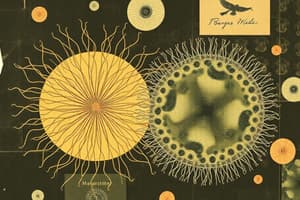Podcast
Questions and Answers
What is the main difference between eukaryotes and prokaryotes?
What is the main difference between eukaryotes and prokaryotes?
Eukaryotes have a well-defined nucleus and organelles covered with membranes, while prokaryotes do not have a well-defined nucleus or nuclear membrane.
Where are chromosomes found in a cell and what is their function?
Where are chromosomes found in a cell and what is their function?
Chromosomes are found in the nucleus of a cell. Their function is to carry genes and help in the transfer of characteristics from parents to offspring.
Why do plant cells have an additional layer surrounding the cell membrane? What is this layer called?
Why do plant cells have an additional layer surrounding the cell membrane? What is this layer called?
Plant cells have an additional layer called the cell wall for protection against extreme climatic conditions and to provide shape and support to the cell.
Why are chloroplasts found only in plant cells?
Why are chloroplasts found only in plant cells?
What is the role of chlorophyll in plant cells?
What is the role of chlorophyll in plant cells?
Flashcards are hidden until you start studying
Study Notes
Cellular Organisms
- Unicellular organisms are made up of a single cell, e.g., Amoeba, paramecium.
- Multicellular organisms are made up of more than one cell, e.g., human beings, plants, animals.
Amoeba
- Amoeba has pseudopodia (false feet) that facilitate movement and help in capturing food.
Nerve Cells
- Nerve cells help in transferring messages from various body parts to the brain and from the brain to various parts of the body.
- They also help in coordinating the functions of the organs in the body.
Cellular Structure
- Cytoplasm is a jelly-like substance between the nucleus and cell membrane, made up of carbohydrates, proteins, and water.
- Nucleus is spherical in shape, located in the center of the cell, and contains genetic material like RNA and DNA.
Cell Functions
- Cells are the basic structural units of living organisms.
- Cells contain all the necessary structures required to carry out various biological processes.
- A group of cells makes a tissue, which further makes organs and finally an organism.
Cell Types
- Eukaryotes have a well-defined nucleus and organelles covered with membranes, e.g., plant cells, animal cells.
- Prokaryotes do not have a well-defined nucleus and nuclear membrane, e.g., bacteria, blue-green algae.
Chromosomes
- Chromosomes are thread-like structures found in the nucleus of a cell.
- Chromosomes carry genes and help in the transfer of characters from parents to the offspring.
Plant Cells
- Plant cells have an additional layer surrounding the cell membrane called the cell wall, which provides protection, shape, and support.
- Chloroplasts are found only in plant cells and contain chlorophyll, which plays a role in photosynthesis.
Studying That Suits You
Use AI to generate personalized quizzes and flashcards to suit your learning preferences.




